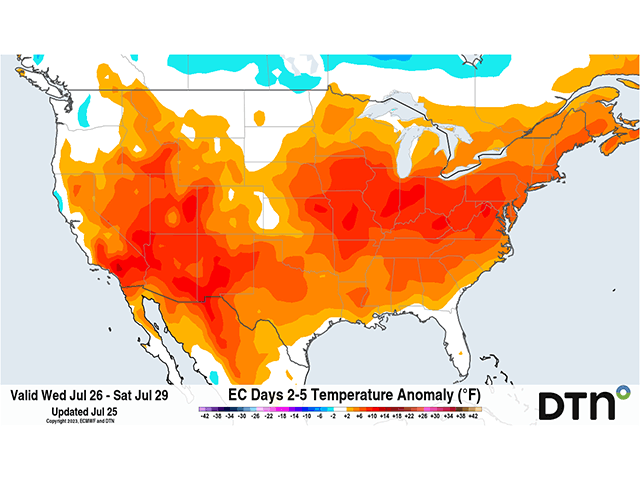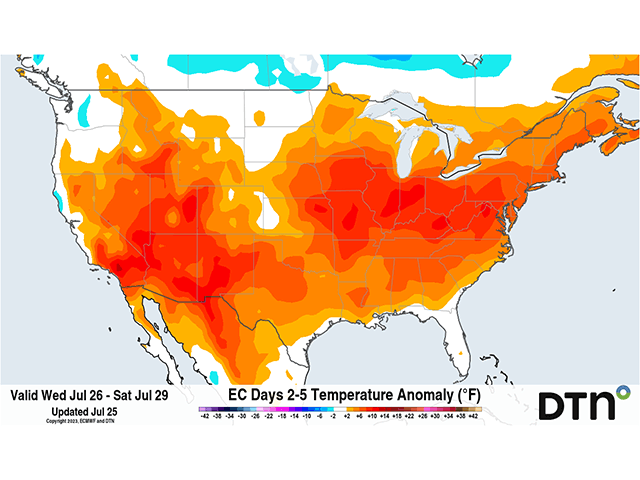Ag Weather Forum
How Extreme Heat Can Affect Corn Yield
The potential impact of extreme heat on crop production continues to dominate market discussion as we approach the final third of the meteorological summer (June, July and August). Extreme temperatures have been building this week and will continue across southern growing areas going into early August.
Research at land grant colleges and by the seed industry have produced many insights into how extreme heat can affect corn yield. Here are some highlights.
It is widely known that corn does not take extreme heat very well. That sensitivity goes back to the origin of corn itself. Corn started out in the highlands of central Mexico at an altitude of more than 7,000 feet to more than a thousand feet higher than Denver, Colorado.
In that part of the world, the daytime is warm while the nights are cool. The corn plant maintains those characteristics today. Corn yields decline when temperatures accumulate above 86 degrees Fahrenheit (30 degrees Celsius).
P[L1] D[0x0] M[300x250] OOP[F] ADUNIT[] T[]
Extreme heat impact on corn production shows up beginning at pollination. Public and private studies have found that temperatures above 95 F can depress corn pollen production. Also, if hot weather is accompanied by high humidity, pollen may not drop from the tassel onto the silk. A third pollination complication is that prolonged heat can reduce pollen production and viability.
Following pollination, extreme heat causes yield loss potential through intensification of water stress rather than the direct effect of heat itself. Higher temperatures cause the transpiration rate of plants to increase, placing a greater demand on soil water supply and potentially accelerating the onset of drought stress.
When the corn plant is under water stress, it closes its stomata (pores which regulate gas exchange between the plant and the environment and control water loss). By closing the stomata, the corn plant can preserve water. But closing this pore also reduces the rate at which the corn plant can take in carbon dioxide for photosynthesis, which in turn leads to yield loss.
A University of Nebraska-Lincoln article on heat stress and corn yield impact noted: "Corn is a 'C4 Photosynthesis' plant, making it extremely efficient at capturing light and fixing CO2 (carbon dioxide) into sugars. One drawback of this system is that with high daytime temperatures, the efficiency of photosynthesis decreases, so the plant makes less sugar to use or store. High nighttime temperatures increase the respiration rate of the plant, causing it to use up or waste sugars for growth and development. This results in the plant making less sugar but using up more than it would during cooler temperatures."
That yield loss potential is notable. If soil moisture is adequate, one day of heat with temperatures in the mid-90s Fahrenheit does not stress the corn plant. But if this heat continues over four consecutive days, corn yield can drop by 1% for each day above that temperature. The potential yield loss is even greater after the fifth or sixth day.
A significant additional detail: Damage caused by extreme heat can be partially mitigated by irrigation or increased precipitation, but not eliminated. Once a kernel is lost because of very hot conditions, the corn plant will not get it back.
As much as the 2023 summer season has featured extreme heat worldwide, there are even more days with this kind of heat ahead in the future, according to climate science projections. Those increases in the number of extreme heat days during the growing season could limit corn adaptability and productivity.
The full University of Nebraska-Lincoln article on corn response to extreme heat is available here: https://cropwatch.unl.edu/….
Read more about the heat forecast from DTN Ag Meteorologist John Baranick here: https://www.dtnpf.com/….
Bryce Anderson can be reached at Bryce.Anderson@dtn.com
(c) Copyright 2023 DTN, LLC. All rights reserved.






Comments
To comment, please Log In or Join our Community .